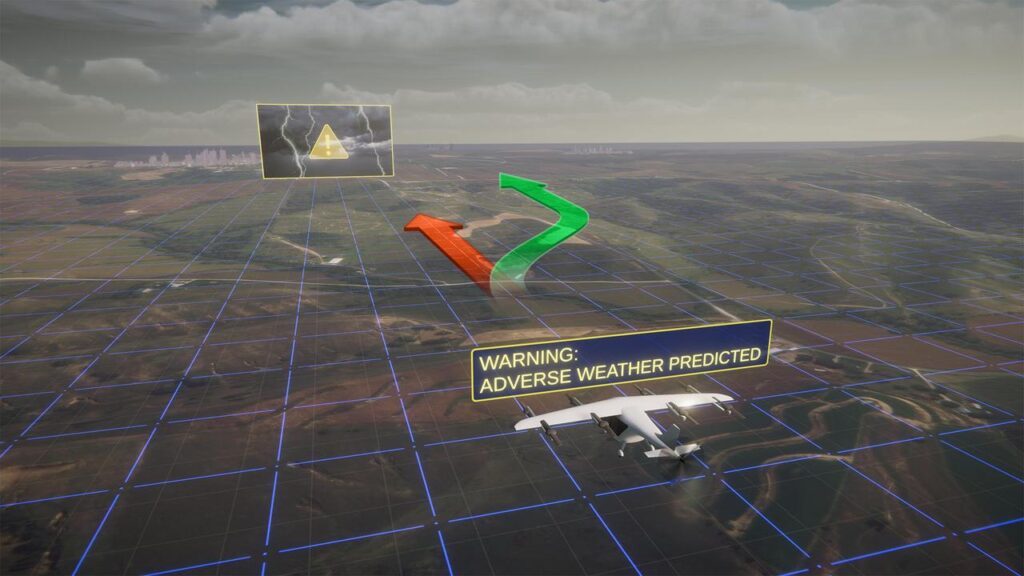 Advancing Drone Safety: How NASA’s Weather Research Supports BVLOS Operations
Advancing Drone Safety: How NASA’s Weather Research Supports BVLOS Operations
by DRONELIFE Contributing Editor Paul Rossi
As the aviation industry expands into increasingly automated technologies, the need for precise weather data becomes undeniably crucial, particularly for drone operations. During the recent AUVSI Xponential 2024, I had the opportunity to sit down with Nancy Mendonca, Deputy NASA Advanced Air Mobility Mission Integration Manager, to discuss the strides NASA is making in this vital area. Our conversation offered profound insights into how weather research is becoming a backbone for safe drone flights, particularly those beyond visual line of sight (BVLOS).
Exploring New Frontiers in Weather Data Utilization
Mendonca began by outlining the new methods NASA is exploring to enhance weather data capture and integration for drone operations. “Our approach involves identifying and supporting companies that could potentially complete the processes the FAA is developing while also complying with ASTM standards,” she explained. This strategy is central to advancing the integration of new weather data, which is pivotal for the operational safety and efficiency of drones.
This endeavor aligns with NASA’s broader goal to support the development of technologies that enable unmanned aircraft systems to fly safely in national airspace, especially in adverse weather conditions that are challenging for light, sensitive drones.
The Critical Role of Weather Research in BVLOS Operations
When asked about the importance of weather-related research for BVLOS drone operations, Mendonca emphasized its critical nature. “Drones are inherently lighter and more susceptible to adverse weather compared to traditional aircraft. In traditional aviation, the pilot also acts as a weather sensor,” she noted, highlighting the vulnerability of drones to environmental elements and the consequent need for robust weather data.
This research is not just about understanding current weather conditions but also about predicting potential changes that could impact drone performance and safety. Advanced weather prediction technologies are therefore a key focus for NASA, aiming to safeguard these operations from the unpredictability of weather.
Advancements in Weather Prediction Technologies
Mendonca was particularly enthusiastic about the advancements NASA has made in weather prediction technologies, which could significantly benefit small drone operations. “We are actively helping small businesses through the Small Business Innovation Research (SBIR) program to improve the sensors, their functions, and capabilities. This, in turn, helps agencies like NOAA produce better models and forecasts,” she shared.
These technological enhancements are crucial for developing more reliable and precise weather prediction models that can forecast sudden atmospheric changes, providing drone operators with the information needed to make safer flight decisions.
Key Takeaways for DroneLife.com Readers
For enthusiasts and professionals reading DroneLife.com, Mendonca’s message was clear: significant progress is being made in qualifying providers of data and hardware essential for advanced drone operations. “WINDMAP in collaboration with Oklahoma State University, is a prime example, where we are putting weather sensors directly on drones to gather real-time data,” she highlighted. This initiative is part of a broader effort by NASA to not only enhance the safety and efficiency of drone operations through improved weather research but also to foster an environment where technological innovation can thrive, ensuring the skies remain safe for the drones of tomorrow.
The conversation with Mendonca provided a detailed look at how critical weather research is to the future of drone operations. With NASA’s ongoing projects and partnerships aimed at harnessing the power of advanced weather data, the horizon looks promising for the safety and reliability of BVLOS drone flights.
Read more:

 Paul Rossi is the Chief Operations Officer and Chief Pilot atNine Ten Drones, a N. C.-based drone services company, training center, and reseller. Rossi is also the Outreach Coordinator for the North Carolina Chapter of AUVSI. A graduate of Embry Riddle Aeronautical University and the U.S. Army Aviation Logistics School, Rossi is passionate about the aviation industry. He holds both a private pilot’s license for manned aircraft and a Part 107 Remote Pilot’s Certificate. You can see more videos and product information on the Nine Ten Drones YouTube channel.
Paul Rossi is the Chief Operations Officer and Chief Pilot atNine Ten Drones, a N. C.-based drone services company, training center, and reseller. Rossi is also the Outreach Coordinator for the North Carolina Chapter of AUVSI. A graduate of Embry Riddle Aeronautical University and the U.S. Army Aviation Logistics School, Rossi is passionate about the aviation industry. He holds both a private pilot’s license for manned aircraft and a Part 107 Remote Pilot’s Certificate. You can see more videos and product information on the Nine Ten Drones YouTube channel.
Miriam McNabb is the Editor-in-Chief of DRONELIFE and CEO of JobForDrones, a professional drone services marketplace, and a fascinated observer of the emerging drone industry and the regulatory environment for drones. Miriam has penned over 3,000 articles focused on the commercial drone space and is an international speaker and recognized figure in the industry. Miriam has a degree from the University of Chicago and over 20 years of experience in high tech sales and marketing for new technologies.
For drone industry consulting or writing, Email Miriam.
TWITTER:@spaldingbarker
Subscribe to DroneLife here.
